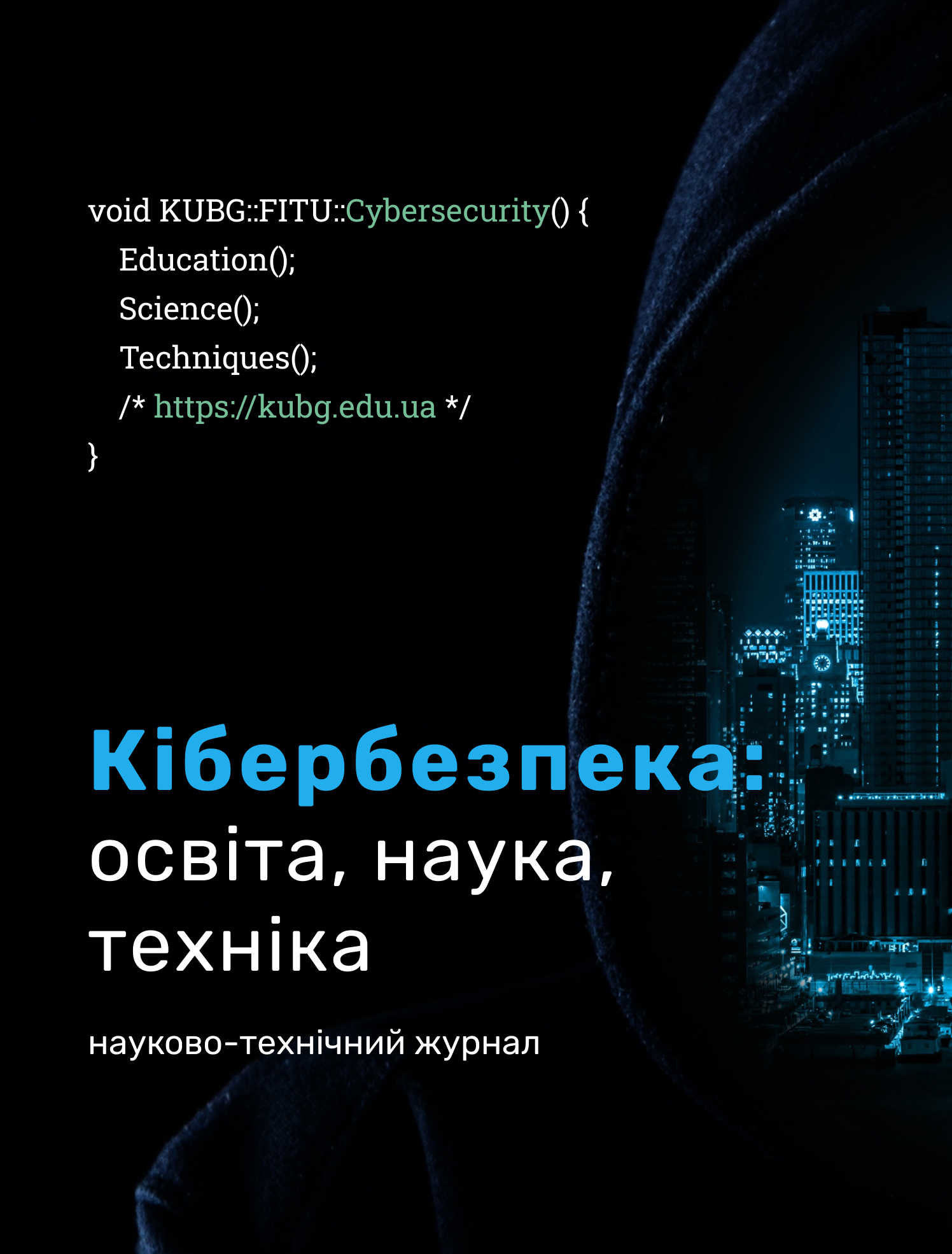SYSTEM TO COLLECT INFORMATION WHEN TRANSFERRING DATA TO RADIO CHANNELS
DOI:
https://doi.org/10.28925/2663-4023.2022.15.634Keywords:
authorization, authentication, wireless network, Wi-Fi, model, encryption algorithm, keys, digital signature, password, information securityAbstract
This article is devoted to solving the problem of information protection in radio channels, by applying comprehensive measures to protect against possible attacks aimed at intercepting and substituting transmitted data. The aim of the work is to analyze the security of wireless networks, identify methods for their protection and create a model for protecting wireless networks. In order to achieve this goal, the following list of tasks was performed: the existing solutions in the field of information protection through radio networks were analyzed; the description of the offered developed model is made; algorithms, experiments, experiments of this model are described. A means of protecting information through radio networks has been developed, the application of which has a significant increase in the level of information security in the radio channel. The practical value of this development is that the theoretical and practical results are recommended for implementation in organizations that use the radio channel to transmit confidential information with high security requirements
Downloads
References
Vyliam, S. (2001). Kryptohrafyia y zashchyta setei: pryntsypy y praktyka (2-he vyd.). Vyliams.
Partyka, T., Popov, Y. (2002). Informatsyonnaia bezopasnost. Forum - Infra.
Uspenskyi, A. Yu., Yvanov, Y. P. (2002). Analyz problem zashchyty ynformatsyy v radyokanalakh standarta IEEE 802.11. Vestnyk MHTU. Ser. Mashynostroenye, (4), 102–108.
Nedashkivskiy, O., Havrylko, Y., Zhurakovskyi, B. Boiko, J. (2020). Mathematical Support for Automated Design Systems for Passive Optical Networks Based on the β-parametric Approximation Formula. International Journal of Advanced Trends in Computer Science and Engineering, 9(5), 8207–8212. https://doi.org/10.30534/ijatcse/2020/186952020
Zetter, K. (2014). How thieves can hack and disable your home alarm system. Wired Magazine. https://www.wired.com
Uspenskyi, A. Yu. (2002). Yssledovanye vozmozhnosty y metody protyvodeistvyia perekhvatu zashchyshchennoi pry pomoshchy protokola WEP ynformatsyy v radyokanale standarta IEEE 802.11. U Studencheskaia nauchnaia vesna (p. 89–91).
Zhurakovskyi, B.Iu, Varfolomeieva, O.H., Hladkykh, O.V., Khakhliuk, O.A. (2013). Obiektno-oriientovana tekhnolohiia proektuvannia system upravlinnia. Visnyk Derzhavnoho universytetu informatsiino-komunikatsiinykh tekhnolohii, (1), 49-53.
Zhurakovskyi, B.Iu. (2012). Obiektno-oriientovana model systemy upravlinnia merezheiu NGN. Visnyk Derzhavnoho universytetu informatsiino-komunikatsiinykh tekhnolohii, (2), 81-84.
Druzhynin, V., Toliupa, S., Pliushch, O., Stepanov, M., Zhurakovskyi, B. (2020). Features of processing signals from stationary radiation sources in multi-position radio monitoring systems. In Cybersecurity Providing in Information and Telecommunication Systems 2020 (p. 46–65). CEUR Workshop Proceedings. http://ceur-ws.org/Vol-2746/
Jesse, R. (2000). Unsafe at any key size; An analysis of the WEP encapsulation.
Zhurakovskyi, B. Yu. (2012). Doslidzhennia vykorystannia novykh zavadostiikykh kodiv dlia kanaliv zi styranniam. Visnyk Derzhavnoho universytetu informatsiino-komunikatsiinykh tekhnolohii, (2), 93-96.
Nedashkivskyy, O.L., Zinenco, Yu.M., Tkachenko O.M. and Korshun, N.V. (2017) Methods of creating passive optical networks with the "distributing bus" topology, Control, Navigation and Communication Systems. Academic Journal, 2(42), 206-217. http://journals.nupp.edu.ua/sunz/article/view/1175
Zhurakovskyi, B. Yu. (2021). Tekhnolohii internetu rechei (B. Yu. Zhurakovskyi I. O. Zeniv, Red.). KPI im. Ihoria Sikorskoho. https://ela.kpi.ua/handle/123456789/42078
Zhurakovskyi, B.Iu. Moshenchenko, M.S. (2020). Standarty Smart City. Aktualnye nauchnye yssledovanyia v sovremennom myre, (2), 41–44.
Zhurakovskyi, B., Toliupa, S., Otrokh, S., Dudarieva, H., Zhurakovskyi, V. (2021). Coding for Information Systems Security and Viability. In Selected Papers of the XX International Scientific and Practical Conference "Information Technologies and Security" 2020 (p. 71–84). CEUR Workshop Proceedings.
Zhurakovskyi, B.Iu. (2021). Model bezprovidnoi merezhi interaktyvnoi infrastruktury SmartCity. Elektronne fakhove naukove vydannia "Kiberbezpeka: osvita, nauka, tekhnika", 1(13), 63-80. https://doi.org/10.28925/2663-4023.2021.13.6380
Nedashkivskiy, O. (2017). Precise method of balancing passive optical networks with irregular splitter with two or more outputs. In 2nd International Conference on Advanced Information and Communication Technologies (AICT) (p. 228–231). https://doi.org/10.1109/AIACT.2017.8020107
Moshenchenko, M., Zhurakovskyi, B. (2021). Information protection in “smart city” technologies. Cybersecurity: Education, Science, Technique, 3(11), 100–109. https://doi.org/10.28925/2663-4023.2021.11.100109.
Barker, E. B., & Kelsey, J. M. (2007). Recommendation for random number generation using deterministic random bit generators (revised). National Institute of Standards and Technology. https://doi.org/10.6028/nist.sp.800-90.
Zhurakovskyi, B.Iu. (2007). Imitatsiina model kanalu upravlinnia i matematychni metody zavadostiikoho koduvannia. Visnyk Derzhavnoho universytetu informatsiino-komunikatsiinykh tekhnolohii, Spetsvypusk, 114 – 119.
Poltorak, V. P., Zhurakovskyi, Yu. P., Zhurakovskyi B. Yu. (1998). Polynomyalnoe kodyrovanye ynformatsyy v systemakh upravlenyia. In 5-a Ukrainska konferentsiia z avtomatychnoho upravlinnia "Avtomatyka-98" (p. 270–271).
Zhurakovskiy, B., & Tsopa, N. (2019). Assessment technique and selection of interconnecting line of information networks. In 2019 3rd international conference on advanced information and communications technologies (AICT). IEEE. https://doi.org/10.1109/aiact.2019.8847726.
Nedashkivskyy, O.L. (2017). Methods of creating passive optical networks with the «bus» topology. Scientific Proceeding of the State University of Telecommunications, 3(47), 42–49. http://journals.dut.edu.ua/index.php/sciencenotes/article/view/1648/1574.
Sandberg, J. (2001). Hackers poised to land at wireless AirPort. ZDNet.
Chmora, A. (2002). Sovremennaia prykladnaia kryptohrafyia. Helyos.
Zhurakovskyi, B., Toliupa, S., Druzhynin, V. (2022). Calculation of Quality Indicators of the Future Multiservice Network. Future Intent-Based Networking, (831), 197–209. https://doi.org/10.1007/978-3-030-92435-5_11
Klove, T. (2007). Codes for Error Detecting. Ch. 2. World Scientific Publishing Company.
WiFi Security: WEP, WPA, WPA2 And Their Differences. NetSpot. https://www.netspotapp.com/wifi-encryption-and-security.html
Shnaier, B. (2002). Prykladnaia kryptohrafyia. Protokoly, alhorytmy, yskhodnye teksty na yazyke SY. Tryumf.
Shevchenko, O., Bondarchuk, A., Polonevych, O., Zhurakovskyi, B., Korshun, N. (2021). Methods of the objects identification and recognition research in the networks with the IoT concept support. In Proceedings of Selected Papers of the Workshop on Cybersecurity Providing in Information and Telecommunication Systems (p. 277–282). CEUR Workshop Proceedings. http://ceur-ws.org/Vol-2923/
Encryption Algorithm II http://www.ncat.edu/~grogans/main.htm
Lima, L., Vilela, J. P., Barros, J., Medard, M. (2008). An information-theoretic cryptanalysis of network coding - is protecting the code enough? У 2008 International Symposium on Information Theory and Its Applications (ISITA). IEEE. https://doi.org/10.1109/isita.2008.4895420.
Novotny, M., Kasper, T. (2009). Cryptanalys is of kee Loqwith COPOCOBANA. In SHARCS 2009 Conferece.
Zhurakovskyi, B. Yu. (2020). Kompiuterni merezhi. Chastyna 2 Navchalnyi posibnyk (B. Yu. Zhurakovskyi I. O. Zeniv, Red.). KPI im. Ihoria Sikorskoho. https://ela.kpi.ua/handle/123456789/36641
Contributors to Wikimedia projects. (2007). IEEE 802.11a-1999 - Wikipedia. Wikipedia, the free encyclopedia. https://en.wikipedia.org/wiki/IEEE_802.11a-1999
Shim, R. (2001). How to Fill Wi-Fi's Security Holes. ZDNet.




